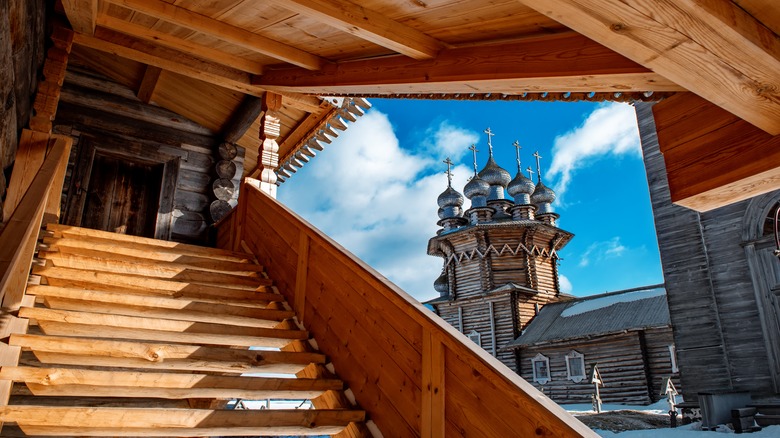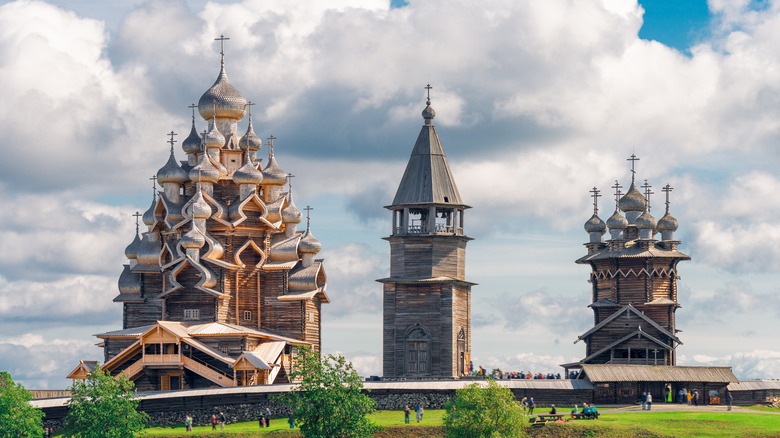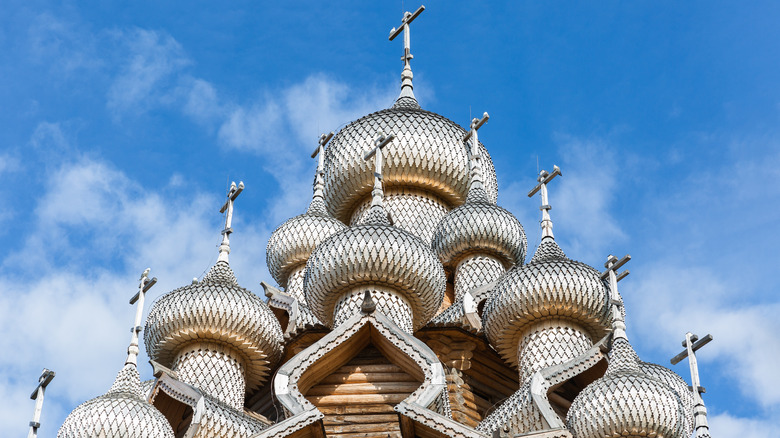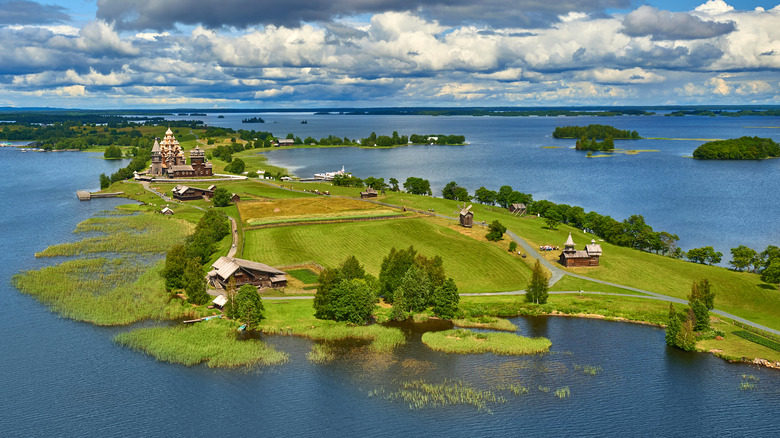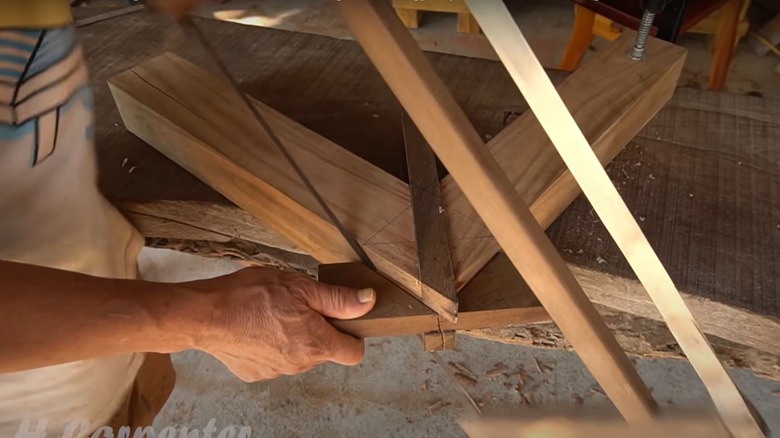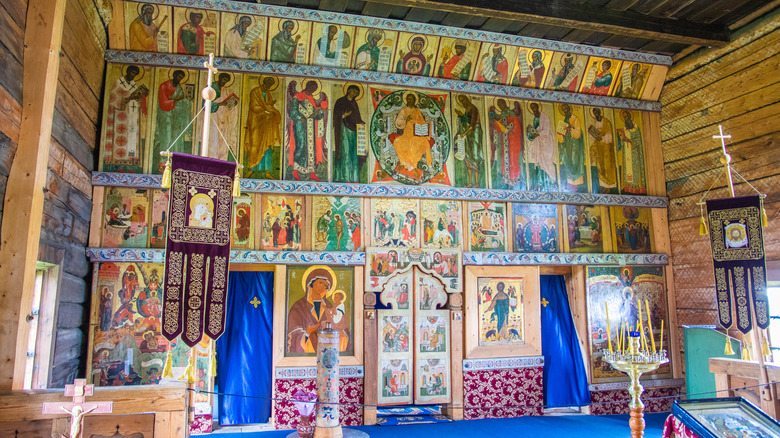Russia's Centuries-Old Churches Defy Modern Construction Methods
Typically, when people think of a church, they might envision one of several varieties. We've got your modest, Lutheran- or Methodist-type church stripped of adornments. We've got the colossal, ornate, Catholic cathedrals built on nothing less than absolute adornment. More recently, we've got those stadium-style megachurches with a massive stage for a band and singers. Local non-denominational groups, however, might just rent out a school gym or other plain space.
Out of these options, gigantic cathedrals tend to get the most attention. After all, they're as beautiful as they are imposing. That was the point — to demonstrate the power of the Almighty and reflect God's glory. As Durham World Heritage says, lots of these structures got built from the mid-12th century in Europe. The Crusades started petering off, and the church start gathering money from indulgences. More cash in the coffer meant more lavish structures and decor. Before then churches weren't made of stone, but cheaper materials like wood, such as Turku Cathedral in Finland.
So how about churches that rival the splendor of the most ornate medieval cathedrals, but are composed 100% of wood? And we don't just mean support structures, roofs, and decorative elements — we mean not a single nail anywhere. Such is the case with the Churches of the Transfiguration and the Intercession, and their octagonal clock tower, on Kizhi Island in Lake Onega in western Russia. A UNESCO World Heritage Site, it's called the "the true eighth wonder of the world" with good reason.
Rebuilt and restored again and again
To be clear: the Church of the Transfiguration, Church of the Intercession, and bell tower we see today are not the original versions. Building with wood has its drawbacks, after all. The current churches have been rebuilt, reconstructed, and restored again and again over centuries. All three structures got renovated in the 1990s, as Russia Beyond says. Before that, the Church of the Intercession was completely rebuilt in 1963 because of an accident with a bonfire. Before that, all three buildings were restored in 1862, then "considerably reconstructed" in 1874, per UNESCO. Before that, the previous versions had been struck by lightning in 1693 and burned down a first time. Slate says that it took until 1714 to rebuild the Church of the Transfiguration, and 1764 to rebuild the Church of the Intercession. The latter was built on the site of an old monastery.
You could imagine that Russian weather doesn't really help the situation. If you take a single piece of cut wood and chuck it outside, how well does it hold up in damp, rain, snow, and the rest of the weather? Moreover, these churches on Kizhi Island are not short — the Church of the Transfiguration is about 120 feet tall. They're also without cover and totally exposed to the elements. But such is the dedication to keeping the structures alive, as well as the insistence on maintaining the churches' traditional forms. They mean a lot, and are even connected to a local legend.
A legendary creation story
The first thing you'll notice when looking at the Churches of the Transfiguration and Intercession is their jaw-dropping beauty. "All wooden church" in this case doesn't mean a barren cube of unpolished timber. The centerpieces of both churches are definitely the domes on top, which resemble minarets on mosques. This makes sense because the Russian Orthodox church gets it religious lineage from Byzantium, aka Constantinople, aka modern-day Istanbul in Turkey. Byzantium was the seat of the eastern half of the ancient Roman empire positioned at a cultural, religious, and economic crossroads. After the western half of the empire died, Byzantium lasted almost a thousand years more, until 1453 C.E. (per History).
But who built the churches on Kizhi Island, and why? No one really knows. At most, we've got some local tales about a builder who used some sort of mythical ax during construction, as Atlas Obscura recounts. When the churches were done, he lifted the ax in the air, proclaimed, "There was not and will be not another one to match it," and chucked the tool in the lake next to the church. Tatiana Nezvitskaya, however — deputy director at the Kizhi Museum — says differently. On The Art Newspaper, she states that the builder's name was Master Nestor, and when he chucked his ax into Lake Onega he was citing the church's unique architecture, not the ax's unique powers. He said, "There never had been and would never be another church like it again."
The eighth wonder of the world
In 1990 UNESCO placed not only the Churches of the Transfiguration and Intercession on its World Heritage List, but all of Kizhi Island. That's because the island, its buildings and settlement, are one entire "pogost," a term used for old government districts. There are only five pogosts left, and as UNESCO says, "Kizhi Pogost offers an outstanding example of an architectural ensemble typical of medieval and post-medieval Orthodox settlements in sparsely populated regions, where missionaries had to cope with far-flung Christian communities and harsh climate." UNESCO also states, "Kizhi Pogost is indeed a unique artistic achievement. Not only does it combine two multi-cupola churches and a bell tower within the same enclosure, but also these unusually designed, perfectly proportioned wooden structures are in perfect harmony with the surrounding landscape."
The latter statement perfectly explains why the churches catch the modern eye. How many modern buildings are just bland, right-angled boxes? How many soulless strip malls clutter this and that landscape? The churches on Kizhi Island are functioning places of worship, yes, but also testaments to artistry and inventiveness. They inspire. This is why the pogost has its own state-funded preservation organization, the Kizhi State Open-Air Museum of History, Architecture, and Ethnography. The museum's website has loads of resources for educators and students, galleries and virtual tours, an e-library, an e-shop, workshops on traditional crafts, and more. As the site says, "Restoration of the Kizhi monuments is being carried out 'in front of the world.'"
Craftsmanship across the world
At this point, "nail-less wooden architecture" might have rung a bell in the minds of some readers. While it's true that the specifics of the design and execution of the Churches of the Transfiguration and Intercession are unique, other countries have their own traditions of all-wooden craftsmanship. These similarities might help us understand how the builders of the Churches of the Transfiguration and Intercession pulled off their feat.
A sample of some woodworking videos on YouTube — a Japanese "miyadaiku" carpenter (here), an elderly man called Grandpa Amu in rural China (here), and an unknown craftsman in Indonesia (here) — all depict the type of immense skill needed to pull off nail-less wooden structures. Basically, the various pieces of wood have to lock together like puzzle pieces. They're carved to perfection, slid in place into slots and grooves cut from other pieces of wood, and assembled into a framework that expands from there. It's kind of like snapping Legos together, except, you know, about a million times more difficult.
On The Art Newspaper, we can see some of the modern reconstruction on Kizhi Island, even a bit of the "interlocking joinery" needed to keep the churches standing. In 2008, Vladimir Putin ordered another overhaul of the churches, including their 40,000 roof shingles. About 36% of the structures needed replacing, which cost about $6.9 million. The craftsmen involved used the same traditional techniques that likely built the churches to begin with.
Church, work of art, and tourist destination
At present, Kizhi Island and its churches are fully accessible to tourists of the more adventurous type. For those willing and able to make the trip — discounting the current Ukraine-Russia war, that is — the aforementioned Kizhi State Open-Air Museum of History, Architecture, and Ethnography has travel and booking information. There are different hours per season, live local weather cams, farmhouses to visit, fires to sit by, hand-baked pies to eat, and more. It's not exactly a small excursion, as the island is over 42 miles from the nearest city, Petrozavodsk. But, not only can you go there by motorboat or hydrofoil in summer, but a helicopter in winter.
It's important to remember that the Churches of the Transfiguration and Intercession are actual churches. As of 2020, they were opened again for regular services, per Ortho Christian; this was the first time in 40 years. The Kizhi Library details how the churches are structured in accordance with the kind of "topographic symbolism" typical of northern Russian Orthodox churches. In other words, the layout of the church has religious significance, such as its east-west interior representing the ascent from earthly life to Heaven. There are six icons inside the Church of Transfiguration, such as St. Nicholas, and sections designated for municipal tasks like recording births, deaths, and marriages. In the end, this is exactly the kind of meaning needed to keep the churches of Kizhi Pogost standing.
